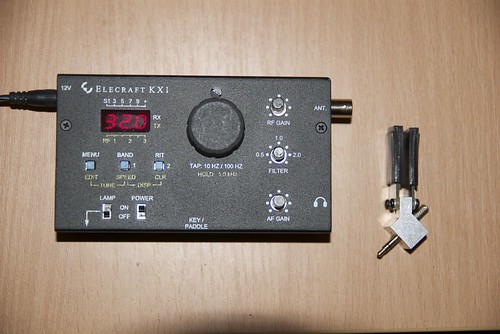Unofficial distance from origin, 6237 miles, 10037 kms (Great Circle Mapper). Unofficial flight duration, 57 hours 2 minutes. (from twitter)
Category Archives: Amateur Radio
Next stop Morocco!
An amateur radio balloon carrying APRS on 144.390 MHz FM has left the USA. Requests have been sent out for APRS operators in the British Isles and Europe to listen for and help track the transatlantic balloon!
The APRS transmission, call sign K6RPT-11, is on 144.390 MHz FM the standard APRS frequency in North America.
At the time of writing, the balloon was South East of the Azores, moving at approx. 225 kph, heading for Morocco. See the link http://aprs.fi/?call=K6RPT-11&mt=roadmap&z=4&timerange=172800&_s=ss_call
Dec 13, 08:40 UTC: It changed course overnight, skipped Morocco, flew slightly North of Malaga and is now heading for Palermo, Italy at about 260kph.
09:25 UTC: It has slowed and dropped several thousand meters since the last beacon. I fear its heading for a dip in the Mediterranean.
09:46:30 UTC: Last packet, 56km/h 4437M
Orbiting Satellite Carrying Amateur Radio
Yesterday was the 50th anniversary of the launch of the first Amateur Radio Satellite, OSCAR 1 (Orbiting Satellite Carrying Amateur Radio). AMSAT UK has put online a telegram sent from the Radio Society of Great Britain, with news that OSCAR 1 had been received in the United Kingdom along with links to several articles on the satellite and an audio clip of it.
AMSAT-OSCAR 51 R.I.P.
Sad to see it go, though I only ever used it a handful of times. There is a certain buzz to be got from briefly speaking to someone from another country through a satellite, that you just don’t get from using the plain old telephone (or skype for that matter).
Weather
We all have an interest in the weather to some level or other. I finally cracked earlier this year and got a weather station, a Davis Vantage VUE with a Weatherlink USB interface.
Unfortunately, not long after I got it the humidity and temperature sensors inexplicably failed. So back to Weathershop, and after a fairly quick turnaround, it has been working fine all Summer.
This weekend, the good weather co-incided with me being at home. So, with permission from SWMBO, the drills came out, and the sensor suite is now mounted in a reasonable location off the gable end of the house (it was in the garden up to now).
The data is available online, using the wview package. It is also available at aprs.fi or findu, as, being into APRS, I’m feeding it into the APRS-IS backbone and contributing to the Citizens Weather Observation Program.
Enjoy!
KX1 #2213
So, the Rugby World cup is over, Vettel has won another Grand Prix, it’s a bank holiday Monday and it is raining buckets out. What do to? Press play on Soldersmoke 137, fire up the soldering-iron and finish building a KX1 of course.
I didn’t get a chance to test it on-air yesterday as my 20m dipole is down and it was too wet to put something up temporarily, but it seems to be working ok into a dummy-load. Next up are the KXAT1 Automatic Antenna Tuning Unit and the 30m/80m module.
FASTRAC
1200mk: fm FAST2 to BEACON ctl UI pid=F0(Text) len 123 23:22:10
F21001633 38263.461363903952.94 -3773326.54 +4430538.23 +0.00000 +0.00000 +0.00000+1297283286 011 015 011 015 018
9600mk: fm FAST2 to FAST1 ctl SABM 23:26:59
9600mk: fm FAST2 to FAST1 ctl SABM 23:27:30
1200mk: fm FAST2 to BEACON ctl UI pid=F0(Text) len 123 23:28:10
F21001633 38263.461363903952.94 -3773326.54 +4430538.23 +0.00000 +0.00000 +0.00000+1315283286 009 014 010 015 019
1200mk: fm FAST2 to BEACON ctl UI pid=F0(Text) len 123 02:37:10
F21001633 38263.461363903952.94 -3773326.54 +4430538.23 +0.00000 +0.00000 +0.00000+1297283286 012 016 010 014 020
9600mk: fm FAST2 to FAST1 ctl SABM 04:21:00
9600mk: fm FAST2 to FAST1 ctl SABM 04:21:05
1200mk: fm FAST2 to BEACON ctl UI pid=F0(Text) len 123 07:43:09
F21001633 38263.461363903952.94 -3773326.54 +4430538.23 +0.00000 +0.00000 +0.00000+1321283286 007 013 009 018 019
FASTRAC
1200mk: fm FAST2 to BEACON ctl UI pid=F0(Text) len 123 08:41:05
F21001633 38263.461363903952.94 -3773326.54 +4430538.23 +0.00000 +0.00000 +0.00000+1348283286 008 014 007 014 024
1200mk: fm FAST2 to BEACON ctl UI pid=F0(Text) len 123 10:23:04
F21001633 38263.461363903952.94 -3773326.54 +4430538.23 +0.00000 +0.00000 +0.00000+1356283286 008 012 008 014 022
Arissat-1
Arissat-1 is hopefully going to be deployed late afternoon Irish time tomorrow, August 3rd. That means switched on and given a bit of a push away from the International Space Station (ISS) during EVA-29.
I was listening for it during testing over the weekend, my time was limited, but unfortunately I didn’t manage to hear any audio from it on the 145.950 downlink, from the mailing lists, it seems some could some couldn’t. As it is much weaker than the ISS
If all goes according to plan, the first areas that should be able to receive it will be South America, very southern South Africa and then southeast Asia.
Steve Bible, N7HPR is blogging about how it was designed and built over the next few weeks on Electronic Engineering Times called “Chips in Space – The Building of an Amateur Satellite“.
I’m looking forward to trying out the linear transponder on it, it will be interesting to see if I can use it with an Omni-directional aerial.
FASTRAC
1200mk: fm FAST2 to BEACON ctl UI pid=F0(Text) len 123 12:50:10
F21001633 38263.461363903952.94 -3773326.54 +4430538.23 +0.00000 +0.00000 +0.00000+1375283286 009 013 009 016 024

